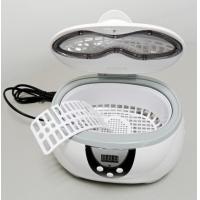3.2L 120W Dental Ultrasonic Cleaner With Heater For Dental Office
How Whale Cleen sonic Dental Ultrasonic Cleaner Works?
Ultrasonic energy creates billions miniature bubbles in tank of the
ultrasonic cleaners that implode with great force separating
impurities from surface of the item you want to clean. Bubbles
formed in cavitation process are capable of reaching into small
cracks and fissures. They are practically mining dirt away from the
surface in a more efficient manner than with manual scrubbing.
Scrubbing has additional disadvantage that it requires staff to
handle contaminated instruments.
Only after a thorough ultrasonic cleaning, disinfection and
sterilization should be preformed. This order is important, because
sterilized items can become contaminated in ultrasonic bath.
Cleaner might contain blood, tissue or other impurities from
previous use.
Specification Of z-s02
| Model | Z-S02(Digital Model) |
| Tank Material | SUS 304 |
| Package | Carton Box Packing |
| Tank size | 240x135x100mm |
| Unit size | 270x170x210mm |
| Carton packing Size | 340x245x310mm |
| Ultrasonic power range | 120W |
| timer | 0~30min adjustable |
| Frequency | 40KHz |
| Tank capacity | 3.2 Liter |
| pcs/carton | 1PCS/carton |
| N.W. | 3.5kg |
| G.W. | 4.1kg |
| Warranty | 1 year |
| Certificate | CE |
Customer's Feedback:

Why You Need Whale cleen sonic Dental Ultrasonic Cleaner?
In most dental practices, instruments are cleaned in an ultrasonic
cleaner. This type of unit removes bioburden by using sound waves
generated by electrical energy.
As the sound waves move through the liquid cleaning solution, they
cause the formation and bursting of millions of small bubbles. This
“cavitation” process functions by disrupting chemical bonds, which
hold the debris on instrument surfaces. This facilitates cleaning.
Only solutions that are formulated specifically for ultrasonic
cleaners are to be used. The resulting cleaning of contaminated
instruments is more efficient as compared to hand scrubbing with a
scrub brush. Cleaning solutions also should be changed at least
daily, or more frequently if visibly contaminated.
For many years, available ultrasonic solutions were detergent-type
cleaners only. These worked by emulsifying oil and water, sometimes
leading to formation of an oil film on the surface.
In the 1960s, a new generation of enzymatic cleaners became
available in various industries. When used in commercial laundry
detergents, the addition of enzymes increased the capability of the
products to clean. It was not until much later that enzymatic
detergent cleaners became available for dental facilities.
Enzymatic cleaners and instrument presoaks (i.e., holding
solutions) are specifically formulated to loosen debris. Initially,
the enzymatic ultrasonic cleaners contained a single proteolytic
enzyme (a protease).
By having the ability to facilitate breakdown of adherent
proteinaceous material (blood and saliva) into water-soluble
components, these preparations were shown to efficiently clean
difficult-to-remove debris from instruments.
Repeated studies demonstrated that they are able to dramatically
reduce the need, if any, for hand scrubbing of instruments.
Virtually all cleaning solutions designed for use in an ultrasonic
unit contain at least one proteolytic enzyme.
As one might expect, enzymatic activity in a cleaner decreases with
frequent use during the day, thereby diminishing the capability of
the protease to break down and remove organic material. Thus, it is
recommended that these cleaning solutions be changed daily, or
sooner, if visibly contaminated.













